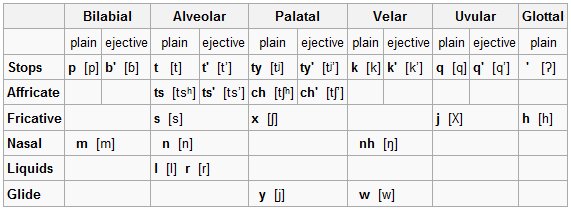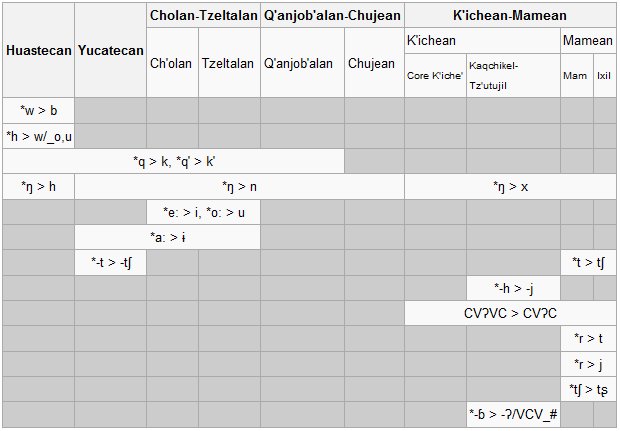Lingua proto-maya
Da Ufopedia.
| Questa voce ha bisogno di essere tradotta. |
Proto-Mayan is the hypothetical common ancestor of the 30 living Mayan languages, as well as the Classic Maya languages documented in the Maya Hieroglyphical inscriptions.
Indice |
Phonology
The Proto-Mayan language is reconstructed (Campbell and Kaufman 1985) as having the following sounds:
Five vowels: a, e, i, o and u. Each of these occurring as short and long: aa, ee, ii, oo and uu,
Sound rules
The following set of sound changes from proto-Mayan to the modern languages are used as the basis of the classification of the Mayan languages. Each sound change may be shared by a number of languages; a grey background indicates no change.
Developments
The palatalized plosives [tʲʼ] and [tʲ] are not carried down into any of the modern families. Instead they are reflected differently in different branches allowing a reconstruction of these phonemes as palatalized plosives. In the eastern branch (Chujean-Q'anjob'alan and Cholan) they are reflected as [t] and [tʼ]. In Mamean they are reflected as [ts] and [tsʼ] and in Yukatek and K'ichean as [tʃʰ] and [tʃʼ].[1]
The Proto-Mayan liquid [r] is reflected as [j] in the eastern languages (Chujean- Q'anjob'alan and Cholan), Huastecan and Yukatek but as [tʃʰ] in Mamean and [r] in K'ichean and Poqom.[1]
Proto-Mayan velar nasal *[ŋ] is reflected as [x] in the western branches (K'ichean Mamean), as [n] in Q'anjob'alan, Cholan and Yukatekan, and only conserved as [ŋ] in Chuj and Poptí.[2] In Huastecan *[ŋ] is reflected as [h].
The changes of Proto-Mayan glottal fricative [h] are many and it has different reflexes according to position. In some positions it has added length to the preceding vowel in languages that preserve a length distinction. In other languages it has the reflexes [w], [j], [ʔ], [x] or a zero-reflex.[3]
Only K'ichean-Mamean and some Q'anjob'alan languages have retained proto-Mayan uvular stops [q] and [qʼ] whereas all other branches have changed these into [k] and [kʼ] respectively.
In Mamean a chain shift took place changing *Template:IPA into Template:IPA, *Template:IPA into Template:IPA, *Template:IPA into Template:IPA and *Template:IPA into Template:IPA. These retroflex affricates and fricatives later diffused into Q'anjob'alan.[4]
In polysyllabic words Kaqchikel and Tz'utujil have changed a final proto-Mayan *[w] and *Template:IPA into [j] and *Template:IPA respectively.[5]
Huastecan is the only branch to have changed Proto-Mayan *[w] into [b]. Wastek also is the only Mayan language to have a phonemic labialized velar phoneme Template:IPA, but this is known to be a postcolonial development. Comparing colonial documents in Wastek to modern Wastek it can be seen that they were originally clusters of k and a rounded vowel followed by a glide. For example the word for "vulture" which in modern Wastek is pronounced Template:IPA was written <cuyx> in colonial Wastek and pronounced Template:IPA.
The Yucatecan languages have all shifted proto-Mayan *[t] into Template:IPA in wordfinal position.
Several languages particularly Cholan and Yucatecan have changed short [a] into Template:IPA.
All Cholan languages have changed long proto-Mayan vowels Template:IPA and Template:IPA into Template:IPA and Template:IPA respectively.
Vowel length distinction has been lost in Q'anjob'alan-Chujean (except for Mocho' and Akateko), Kaqchikel and Cholan. Some languages have reduced the vowel length distinction into a tense lax distinction that was later lost for most vowels, Kaqchikel however retains a centralized lax schwa-like vowel as a reflex of proto-Mayan Template:IPA[6]. Two languages, Yukatek and Uspantek and one dialect of Tzotzil have introduced a tone distinction in vowels between high and low tones as reflexes of former vowel length and [h] and Template:IPA.
Grammar
Vocabulary
References
- England, Nora C., 1994, Autonomia de los Idiomas Mayas: Historia e identidad. (Ukuta'mil Ramaq'iil Utzijob'aal ri Maya' Amaaq'.) Cholsamaj. Guatemala.
- Handbook of Middle American Indians, 1967, 1969, R. Wauchope (series ed.). Vol 7 (ethnographic sketches of Mayan groups), Volume 5 (linguistic sketches and other useful materials). F 1434, H 3, LAC (ref).
- Lyle Campbell and Terrence Kaufman, Annual Review of Anthropology. 1985. "Mayan Linguistics: Where are We Now?".
Bibliography of Maya related topics from the University of Texas Anthropology website
External links
- The Guatemalan Academy of Mayan Languages - Spanish/Mayan site, the primary authority on Mayan Languages
- Yucatec - English Dictionary
- The Mayan Languages- A Comparative Vocabulary contains more than 40,000 entries for 31 Mayan languages
- English Words and their Classic Maya Equivalents
- Ethnologue Mayan language family tree




